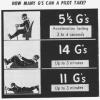Search the Community
Showing results for tags 'flight surgeon'.
-
Hi all, Headed to Wright Patt for my FC1 soon. Can anyone give clarity on what the flight doc looks for when you're asked to perform the Valsalva? I know they look for movement of the tympanic membrane/eardrum but I was hoping to find more clarity on this. I have some scarring my on eardrums from childhood ear infections that otherwise do not affect my hearing or ability to equalize. The Valsalva in particular allows me to clear my ears, though I only hear the "pop" in my left ear. I had a civilian ENT observe this as well and they were able to verify seeing movement in the left ear drum but not the right. I have much better success clearing both ears with the Toynbee Maneuver (swallowing with nose closed) and have used this for scuba diving and unpressurized flights with zero issues (I hear a equally loud pop/clearance for both ears). If I combine this maneuver with the Valsalva, my ears will clear 100% of the time, however I'm not sure that this would generate the ear drum movement in my right ear that the doc may be looking for. That being said, should I expect the flight doc to be evaluating this solely on eardrum movement? I'm guessing they will also ask if your ears cleared, which in my case the answer would truthfully be a yes, even if not visible. In others' experience, could I expect the doc to "take my word for it?" If not, would additional baro chamber testing be expected or allowed? Upon recently reviewing my MEPS paperwork, the doc marked UNSAT for my Valsalva after previously marking and crossing out SAT, which has prompted my concern around this issue. This test seems partly subjective and it would be helpful to know the general outlook that the flight doc may have on this as far as eardrum movement and non Valsalva equalizations go. Interestingly, the Valsalva is mentioned in the Waiver Guide as the standard benchmark for evaluation but mentions the Toynbee and Frenzel maneuvers as safer alternatives to achieve the same result in the very next sentence. Any insight, advice, or recent experience would be greatly appreciated!
-
There are two common points of confusion with flight surgeons. The first is whether or not a military flight doc is a surgeon as understood by the definition of a particular type of physician who carries privileges to perform invasive surgery. The second is whether or not flight docs are pilots. Many junior enlisted members see the flight doc wearing the same uniform, patches, and rank as a pilot and assumes since they fly, they are also pilots. There is another forum post on the pilot physician program, but this makes up only a very small number of individuals. The majority of flight surgeons are: 1. Not surgeons 2. Not pilots The followup question typically questions why a flight doc has a requirement to fly. I've recently written a blog post on this topic to answer the question (https://goflightmedicine.com/flight-surgeons-fly/), but I really see three primary reasons for flight docs to participate in regular flying duties: 1. To better understand/experience aerospace physiologic stressors 2. To appreciate the particular demands of the aircraft and mission of the assignment flying unit 3. To build trust and social relationships with the flyers Flying is one of the coolest parts about being a flight doc and a required duty since the position was invented during WWI. Occasionally, however, an objection is raised as to if this is really a necessary or even a good idea. I'd be interested to hear the comments from the peanut gallery!
- 16 replies
-
- military medicine
- flight doc
-
(and 2 more)
Tagged with:
-
I just recently discovered via research on Google that I have a Pilonidal cyst. I'm a current/qualified AF pilot and was wondering if anyone here has had or known of someone who successfully dealt with this issue and returned to fly? It looks like it's a pretty simple procedure. I just don't want to talk to a flight doc before I can get some feedback.Anyone? Here's what I found in AFI 48-123 regarding the issue. 6.44.20.9. Pilonidal cyst, if there is a history of inflammation or discharging sinus in the 2 years preceding examination. Surgery for pilonidal cyst or sinus is disqualifying until the wound is healed, there are no referable symptoms, and no further treatment or medication is required. Diceman
- 4 replies
-
- Flight Surgeon
- Pilonidal Cyst
-
(and 1 more)
Tagged with:


